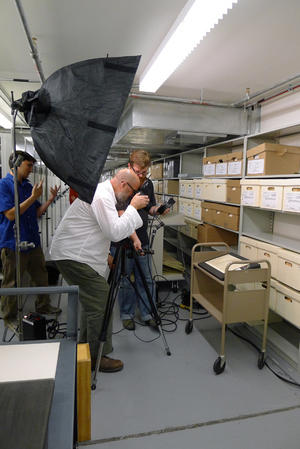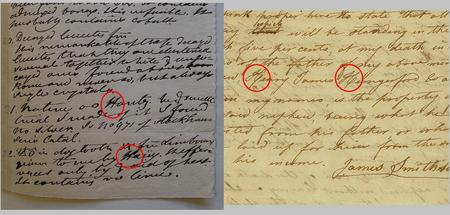This is the first part in a series examining the draft of the will of James Smithson held here at the Archives.
Today we celebrate National Handwriting Day by sharing with you some up-close and personal time with one of our Treasures, the 1826 draft of James Smithson's (founding donor of the Smithsonian) Will and Testament. (The actual Will, handsomely calligraphed, resides in London at the National Register).
We were recently asked by Smithsonian magazine to make the draft Will available for a photo shoot for a special issue which matches our Treasures with photographers of note. I jumped at the chance to do some closer examination while the document was brought out of its secure location. The document has been imaged at least a few times with better and better imaging resolutions since photographic documentation has been in the museum's toolbox, so what was I looking for? In all the times that this document had been imaged for its text, no one had yet recorded the physical aspects of the paper itself, such as fiber quality, watermarks, nor analysis of inks and identifying characteristics of the handwriting.
To begin my research for the potential conservation treatment of the Will, I borrowed my colleague's copy of The Lost World of James Smithson and set to reading. I learned much about the young Smithson’s privileged, yet set-apart background, his travels, influences and his pursuits to make of himself a legacy worthy of respect by his accomplishments if not his questioned entitlements. The book closes with a full chapter on the final Will, but I did start from the beginning to get a sense of the man.

Bringing this back around to the examination of the draft, there I was in the vault, looking at physical factors such as the thickness and evenness of the paper, the watermark, and the quality of the handwriting, with its' curving lines, hasty messy writing and scratched out corrections. I imagined a fevered Smithson in the throes of an illness, alone at his writing-desk dashing off his poignant prose. My eyes surprisingly blurred with tears as I noted the relatively heavy laydown of ink in the word "illegitimate," the insult that had troubled Mr. Smithson all his life.
Later that week while puzzling out the watermark from digital captures, Heather Ewing, author of the biography above, happened to be back in the office. I shared my romantic notions with her and she looked at me straight-faced while saying bluntly: "You know that’s not his handwriting, right? His clerk probably wrote that." My jaw fell, embarrassed but humbled by the reminder to practice one of the chief tenets of conservation: the curator-conservator dialogue. I was so entranced by the physical evidence that I had made an assumption that Smithson wrote the draft, but others’ opinions suggest that he may have dictated it. Our own finding aid description is discreet on this difference of opinion. At the very least, lacking a signature, the manuscript cannot be properly described as a holograph, a manuscript both written and signed by the writer. And while the writer, if a clerk, may or may not have indeed consciously reflected the attitude and inflection of the speaker with an expressive line weight, it is conjecture at best to draw conclusions from that alone.
So, chastened but curiousity piqued, I returned to examine the empirical evidence to support my instinctive reaction. While it is presumed that many of Smithson's original notes perished in the Castle fire of 1865, many confirmed examples of his handwriting exist: in a compiled scrapbook of his specimen collection notes, as marginalia in his library books, and in Ewing's research from across Europe. In these, we will continue to seek points of commonality or difference, such as individual and class characteristics, and many other points considered by Questioned Document Examiners.
![James Smithson's handwriting [item #] 1678. March 2, 1820 on left, compared to the Draft Will of James Smithson on right. Notes in J. R. McD. Irby's arrangement of James Smithson's "Notes on Minerals and Rocks," 1878, p. 24. Composite image courtesy of Nora Lockshin. Record Unit 7000 - James Smithson Collection, Smithsonian Institution Archives. James Smithson's handwriting [item #] 1678. March 2, 1820 on left, compared to the Draft Will of Jam](https://siarchives.si.edu/sites/default/files/imagecache/body-image-450/blog-attached-images/ComparativeAnalysis1.jpg)

As we build our case for or against the draft will being in Smithson's own hand, tell us, what do you think? We promise not to analyze your handwriting, in fact, you can just type your comment below!
Related Resources
- Is that you, John Quincy Adams?, The Bigger Picture blog, Smithsonian Institution Archives
- Smokin' Smithsonian, The Bigger Picture blog, Smithsonian Institution Archives
- 2013 Field Book Handwriting Award, The Field Book Project blog, Smithsonian National Museum of Natural History
Related Collections
- Record Unit 7000 - James Smithson Collection, 1796-1951, c. 1974, 1981-1983, Smithsonian Institution Archives
Produced by the Smithsonian Institution Archives. For copyright questions, please see the Terms of Use.

Leave a Comment